Students must practice these TS Intermediate Maths 1B Solutions Chapter 3 Straight Lines Ex 3(d) to find a better approach to solving the problems.
TS Inter 1st Year Maths 1B Straight Lines Solutions Exercise 3(d)
I. Find the angle between the following straight lines. (V.S.A.Q.)
Question 1.
y = 4 – 2x, y = 3x + 7
Answer:
y = 4 – 2x ⇒ 2x + y – 4 = 0 and
3x – y + 7 = 0 are equations of given lines
If θ is the angle between the lines
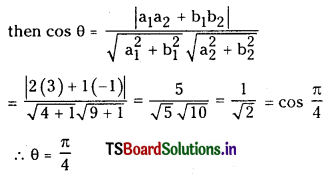
![]()
Question 2.
3x + 5y = 7, 2x – y + 4 = 0 (V.S.A.Q)
Answer:
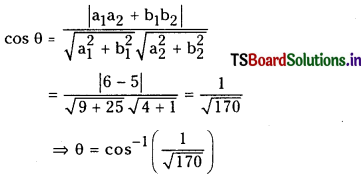
Question 3.
y = – √3 x + 5, y = \(\frac{1}{\sqrt{3}}\)x – \(\frac{2}{\sqrt{3}}\) (V .S.A.Q.)
Answer:
m1 = -√3 and m2 = \(\frac{1}{\sqrt{3}}\) = from the given lines. Since m1m2 = – 1, the lines are perpendicular ⇒ θ = \(\frac{\pi}{2}\)
Question 4.
ax + by = a + b, a(x – y) + b(x + y) = 2b (V.S.A.Q)
Answer:
ax + by = a + b, (a + b)x + (- a + b)y = 2b
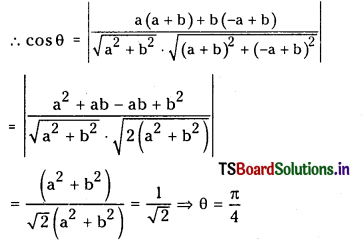
Find the length of the perpendicular drawn from the given point given against the following straight lines.
Question 5.
5x – 2y + 4 = 0; ( – 2, – 3 ) … (V.S.A.Q.)
Answer:
Length of the perpendicular from the point (-2, -3) to the line 5x – 2y + 4 = 0 is by the formula
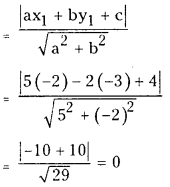
Question 6.
3x – 4y + 10 = 0 ……………… (3, 4) (V.S.A.Q)
Answer:
Length of the perpendicular

Question 7.
x – 3y – 4 = 0 ……………… ( 0, 0 ) (V.S.A.Q.)
Answer:
Length of the perpendicular
= \(\left|\frac{0-3(0)-4}{\sqrt{1+9}}\right|\) = \(\frac{4}{\sqrt{10}}\)
![]()
Find the distance between the following parallel lines. (V.S.A.Q.)
Question 8.
3x – 4y = 12, 3x – 4y = 7
Answer:
Given equations of lines are
3x – 4y = 12, 3x – 4y = 7
So by the formula distance between two parallel lines = \(\frac{\left|c_1-c_2\right|}{\sqrt{a^2+b^2}}\) = \(\frac{|-12+7|}{\sqrt{9+16}}\) = 1
Question 9.
5x – 3y – 4 = 0, 10x – 6y – 9 = 0 (May 2012)
Answer:
Equations of the lines can be taken as
10x – 6y – 8 = 0
10x – 6y – 9 = 0
∴ Distance between two parallel lines
= \(\frac{|-8+9|}{\sqrt{100+36}}\) = \(\frac{1}{2 \sqrt{34}} \)
Question 10.
Find the equation of the straight line parallel to the line 2x + 3y + 7 = 0 and passing through the point (5, 4). (March 2013) (V.S.A.Q.)
Answer:
Equation of the given line is
2x + 3y + 7 = 0 …………………. ( 1 )
We suppose the equation of line parallel to line (1) is 2x + 3y + k = 0 …………………. ( 2 )
Since the required line passes through (5, 4)
we have 2(5) + 3(4) + k = 0 ⇒ k + 22 = 0 ⇒ k = -22
∴ From (2) the equation of the required line is 2x + 3y – 22 = 0
Question 11.
Find the equation of the straight line perpendicular to the line 5x – 3y + 1 = 0 and passing through the point ( 4, – 3). (V.S.A.Q.)
Answer:
Equation of the given line is
5x – 3y – 1 = 0 ……… (1)
The equation of the line perpendicular to (1) is of the form 3x + 5y + k = 0 ……… (2)
If (2) passes through (4, -3) then
3(4) + 5 (- 3) + k = 0
⇒ 12 – 15 + k = 0
⇒k = 3
∴ From (2) the equation of the required line is 3x + 5y + 3 = 0
Question 12.
Find the value of k if the straight lines 6x – 10y + 3 = 0 and kx – 5y + 8 = 0 are parallel.
Answer:
Equations of the given lines are (V.S.A.Q.)
6x – 10y + 3 = 0
kx – 5y + 8 = 0
These lines are parallel, so a1 b2 = a2 b1
⇒ – 30 = – 10 k
⇒ k = 3
Question 13.
Find the value of p if the straight lines 3x + 7y – 1 = 0 and 7x – py + 3 = 0 are mutually perpendicular. (V.S.A.Q.)
Answer:
Equations of the given lines are
3x + 7y – 1 = 0
7x – py + 3 = 0
These lines are perpendicular
⇒ a1 a2 + b1 b2 = 0
⇒ 3(7) + 7(- p) = 0
⇒ 21 – 7p = 0 ⇒ p = 3
![]()
Question 14.
Find the value of k, if the straight lines y – 3kx + 4 = 0 and (2k – 1)x – (8k – 1) y – 6 = 0 are perpendicular. (V.S.A.Q.)
Answer:
Equations of the given lines are
y – 3kx + 4 = 0 and
(2k – 1)x – ( 8k – 1 )y – 6 = 0
The lines are perpendicular
⇒ a1 a2 + b1 b2 = 0
⇒ – 3k (2k – 1) – 1 (8k – 1) = 0
⇒ – 6k2 + 3k – 8k + 1 = 0
⇒ 6k2 + 5k – 1 = 0
⇒ (k + 1) (6k – 1) = 0
⇒ k = – 1 (or) k = 1/6.
Question 15.
(- 4, 5) is a vertex of a square and one of W its diagonals is 7x – y + 8 = 0. Find the equation of the other diagonal. (S.A.Q.)
Answer:
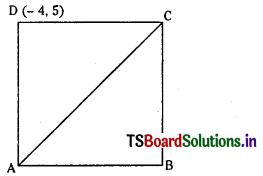
ABCD is a square. Equation of the diagonal is AC given by 7x – y + 8 = 0
The other diagonal BD is perpendicular to AC.
Equation of BD is x + 7y + k = 0. BD passes through D(- 4, 5). Hence – 4 + 7(5) + k = 0
⇒ k = – 31
∴ Equation of the other diagonal BD is x + 7y – 31 = 0
II.
Question 1.
Find the equations of the straight lines passing through (1, 3) and (i) parallel to (ii) perpendicular to the line passing through the points (3, – 5 ) and ( – 6, 1 )
Answer:
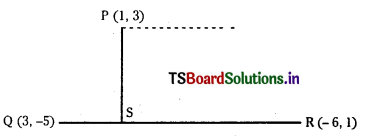
(i) Q(3, – 5) and R(-6, 1) are the given points
Slope of QR = \(\frac{-5-1}{3+6}=\frac{-6}{9}\) = \(\frac{-2}{3}\)
∴ Slope of the line passing through P, parallel to QR is -2/3
∴ Equation of the line is y – 3 = –\(\frac{2}{3}\) (x – 1)
⇒ 3y – 9 = -2x + 2
⇒ 2x + 3y – 11 = 0
(ii) Slope of the line perpendicular to the line QR is 3/2.
∴ Equation of the line passing through P(1, 3) and perpendicular to QR is
y – 3 = 3/2 (x – 1)
⇒ 2y – 6 = 3x – 3
⇒ 3x – 2y + 3 = 0
![]()
Question 2.
The line \(\frac{x}{a}-\frac{y}{b}\) = 1 meets the X – axis at P.
Find the equation of the line perpendicular to this line at P. (S.A.Q.)
Answer:
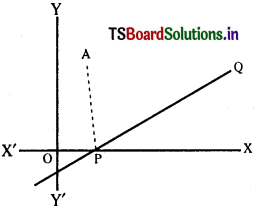
Equation of PQ is \(\frac{x}{a}-\frac{y}{b}\) = 1
Equation of X-axis is y = 0 ∴ x = a
∴ Coordinates of P = (a, 0)
Line PA is perpendicular to PQ
∴ Equation of PA is \(\frac{x}{b}+\frac{y}{a}\) = k
The line PA is passing through (a, 0) hence
\(\frac{a}{b}+\frac{0}{a}\) = k ⇒ k = \(\frac{a}{b}\)
∴ Equation of the line perpendicular to the line PQ at P is \(\frac{x}{b}+\frac{y}{a}=\frac{a}{b}\)
Question 3.
Find the equation of the line perpendicular to the line 3x + 4y + 6 = 0 and making an intercept – 4 on the X-axis. (S.A.Q.)
Answer:
Equation of the given line is
3x + 4y + 6 = 0 ……………. (1)
Equation of the line perpendicular to (1) is 4x – 3y + k = 0
⇒ 4x – 3y = – k

Since the line makes X-intercept – 4 on the X-axis we have – \(\frac{k}{4}\) = – 4 ⇒ k = 16
∴ Equation of the required line is 4x – 3y + 16 = 0
Question 4.
A (- 1, 1), B ( 5, 3 ) are opposite vertices of a square in the XY-planfe. Find the equation of the other diagonal (not passing through A, B ) of the square. (S.A.Q.)
Answer:
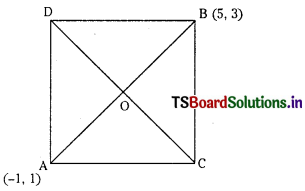
A (- 1, 1), B (5, 3) are opposite vertices of the square.
Slope of AB = \(\frac{3-1}{5+1}=\frac{2}{6}=\frac{1}{3}\)
∴ Slope of CD = – 3
O is the point of intersection of the diagonals
∴ Coordinates of O are
\(\left(\frac{-1+5}{2}, \frac{1+3}{2}\right)\) = (2, 2)
CD passes through 0 (2, 2)
∴ Equation of CD is y – 2 = – 3 (x – 2)
⇒ 3x + y- 8 = 0
Question 5.
Find the foot of the perpendicular drawn from (4, 1) upon the straight line 3x – 4y + 12 = 0. (S.A.Q.)
Answer:
Given equation of the straight line is
3x-4y + 12 = 0 ………………… ( 1 )
Equation of the line perpendicular to (1) is
4x + 3y + k = 0 ……………….. ( 2 )
This line passes through (4, 1) that
4(4) + 3(1) + k = 0 ⇒ k = – 19
∴ Equation of line (2) is 4x + 3y – 19 = 0 …. ( 3 )
Solving (1) and (2) we get the coordinates of the foot of the perpendicular
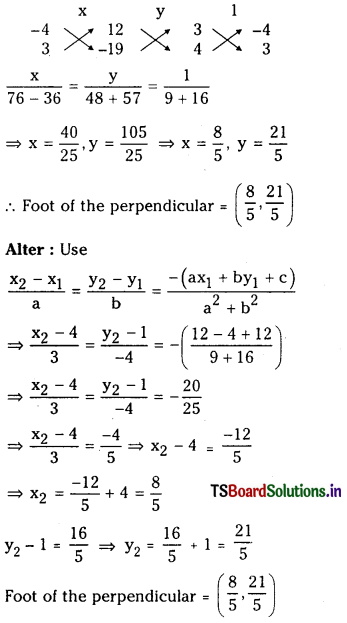
![]()
Question 6.
Find the foot of the perpendicular drawn from (3, 0) upon the straight line 5x + 12y – 41 = 0. (S.A.Q.)
Answer:
Equation of the given line is 5x + 12y – 41 = 0
If (x2, y2) is the foot of the perpendicular from (x1, y1) on the line ax + by + c = 0 then
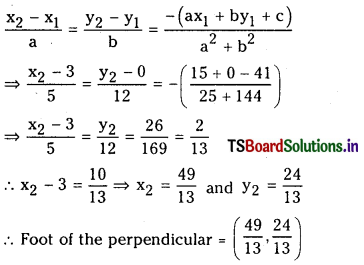
Question 7.
x – 3y – 5 = 0 is the perpendicular bisector of the line segment joining the points A, B. If A = (- 1, – 3 ), find the coordinates of B. (S.A.Q)
Answer:
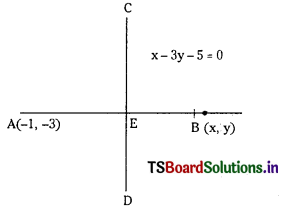
Let (x, y) be the coordinates of B which is the image of A(-1, -3).
Equation of line AB is of the form 3x + y + k = 0
This passes through A(- 1, -3) then
3(- 1) – 3 + k = 0 ⇒ k = 6
∴ Equation of the line AB is
3x + y + 6 = 0 …………………. (1)
Equation of the given line is
x – 3y – 5 = 0 ………………… (2)
Solving (1) and (2) we get the coordinates of E
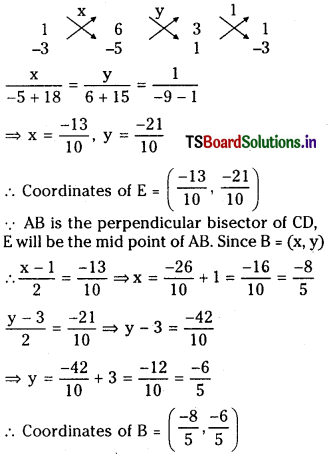
Alter: If (x2, y2) is the image of (x1, y1) with respect to the line ax + by + c = 0 then
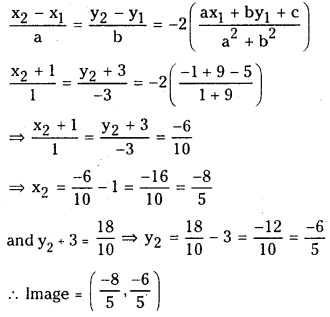
![]()
Question 8.
Find the image of the point (1, 2) in the straight line 3x + 4y – 1 = 0. (S.A.Q.)
Answer:
If (x2, y2) is the image of (x1, y1) with respect to the line ax + by + c = 0 then
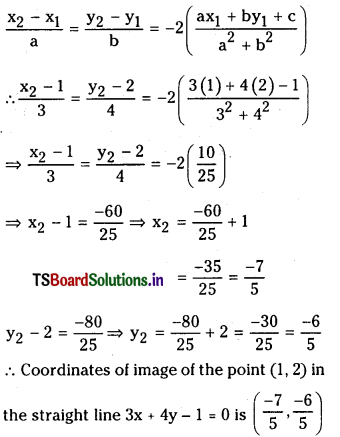
Question 9.
Show that the distance of the point (6, – 2) from the line 4x + 3y = 12 is half the distance of the point (3, 4) from the line 4x – 3y = 12. (S.A.Q.)
Answer:
Distance of the point P(x1, y1) to the line ax + by + c = 0 is \(\left|\frac{a x_1+b y_1+c}{\sqrt{a^2+b^2}}\right|\)
Distance of the point (6, -2) from the line 4x + 3y = 12 is
\(\left|\frac{24-6-12}{\sqrt{4^2+3^2}}\right|=\left|\frac{6}{5}\right|\)
Distance of the point (3, 4) from the line 4x – 3y = 12 is
\(\left|\frac{12-12-12}{\sqrt{4^2+(-3)^2}}\right|=\frac{12}{5}\)
Hence, distance of the point (6, – 2) from the line 4x + 3y = 12 is one half of the distance of the point (3, 4) from the line 4x – 3y = 12
Question 10.
Find the locus of the foot of the perpendicular hum the origin to available straight line which always passes through a fixed point (a, b). (S.A.Q.)
Answer:
m is the slope of the line AB passing through a fixed point A(a, b).
Then the equation of AB is y – b = m (x – a)
⇒ mx – y + (b – ma) = 0 ……………. (1)
Let the locus of the foot of the perpendicular from origin to a variable straight line.
Then equation of the line perpendicular to AB is passing through the origin is
my + x = 0 …………………… (2)
Solving (1) and (2)
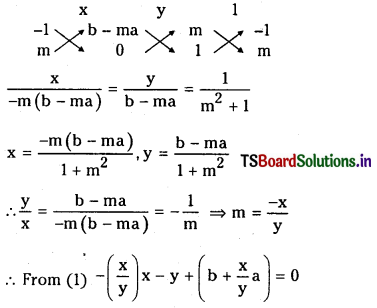
⇒ – x2 – y2 + by + xa = 0
⇒ x2 + y2 – ax – by = 0
∴ Locus of (x, y) is x2 + y2 – ax – by = 0
![]()
III.
Question 1.
Show that the lines x – 7y – 22 = 0, 3x + 4y + 9 = 0 and 7x + y – 54 = 0 form a right angled isosceles triangle. (S.A.Q.)
Answer:
Given lines are
x – 7y – 22 = 0 …………….. (1)
3x + 4y + 9 = 0 …………… (2)
7x + y – 54 = 0 …………….. (3)
Let the angle between lines (1) and (2) be A
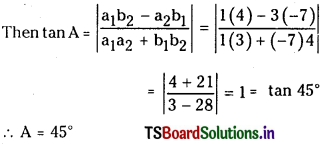
Let the angle between the lines (2) and (3) be B then
tan B = \(\left|\frac{3(1)-7(4)}{3(7)+4(1)}\right|=\left|\frac{-25}{25}\right|\) = 1 = tan 45°
⇒ B = 45°
Let the angle between (1) and (3) be C
Since A + B + C = 180°
we have C = 180 – (A + B) = 180 – 45 – 45 = 90°
Lines (1), (2) and (3) form a right angled isosceles triangle.
Question 2.
Find the equation of straight lines passing through the point (- 3, 2) and making an angle of 45° with the straight line 3x – y + 4 = 0 (S.A.Q)
Answer:
Given (x1, y1) = (- 3, 2)
and given line is 3x – y + 4 = 0 ………………… (1)
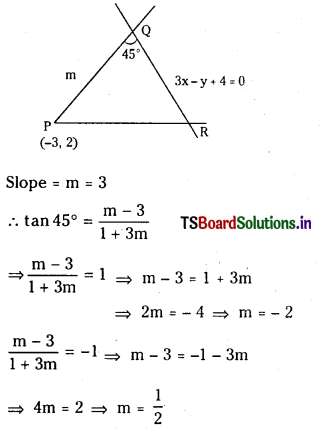
Case (i): m = – 2
Equation of line PR is y – 2 = – 2(x + 3)
⇒ 2x + y + 4 = 0
Case (ii): m = \(\frac{1}{2}\)
Equation of the line PR is
y – 2 = \(\frac{1}{2}\) (x + 3)
⇒ 2y – 4 = x + 3 ⇒ x – 2y + 7 = 0
Question 3.
Find the angles of the triangle whose sides are x + y – 4 = 0, 2x + y – 6 = 0 and 5x + 3y – 15 = 0 (S.A.Q.)
Answer:
Let the equations of sides AB, BC and CA of the triangle ABC be x + y – 4 = 0,
2x + y – 6 = 0 and 5x + 3y – 15 = 0
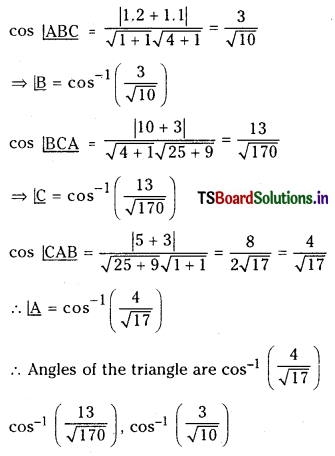
![]()
Question 4.
Prove that the feet of the perpendiculars from the origin on the lines x + y = 4, x + 5y = 26 and 15x – 27y = 424 are collinear. (E.Q.)
Answer:
Given the lines
x + y – 4 = 0 ………………… ( 1 )
x + 5y – 26 = 0 ………………. ( 2 )
15x – 27y – 424 = 0 ……………….. (3)
Let P (x2, y22) be the foot of the perpendicular of (x1, y1) = (0, 0) on (1)
⇒ \(\frac{x_2-0}{1}=\frac{y_2-0}{1}\) = \(\frac{-(0+0-4)}{1+1}=\frac{4}{2}\) = 2
∴ x2 = 2, y2 = 2 ∴ P = (2, 2)
Let Q (x3, y3) be the foot of the perpendicular of (x1, y1) = (0, 0) on (2)
\(\frac{x_3-0}{1}=\frac{y_3-0}{5}\) = \(\frac{-(0+0-26)}{1+25}\) = \(\frac{26}{26}\) = 1
∴ x3 = 1, y3 = 5 ⇒ Q = (1, 5)
Let R (x4, y4) be the foot of the perpendicular of (x1, y1) = (0, 0) on (3)
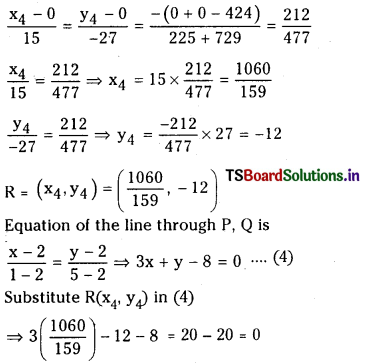
∴ Foot of the perpendicular of origin on the lines lies on a straight line.
Question 5.
Find the equations of straight lines passing through the point of intersection of the lines 3x + 2y + 4 = 0, 2x + 5y = 1 and whose distance from ( 2, – 1) is 2. (E.Q.)
Answer:
Equation of the lines passing through the point of intersection of the line
L1 = 3x + 2y + 4 = 0,
L2 = 2x + 5y – 1 = 0 is of the form
L1 + λL2 = 0
⇒ (3x + 2y + 4) + λ(2x + 5y – 1) = 0
⇒ (3 + 2λ)x + (2 + 5λ)y + (4 – λ) = 0 …………… (1)
Given that the distance from (2, -1) to (1) is 2
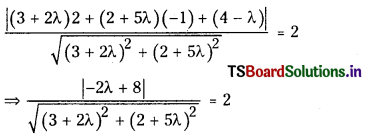
⇒ (- λ + 4)2 = 9 + 4λ2 + 12λ + 4 + 25λ2 + 20λ
⇒ 28λ2 + 40λ – 3 = 0
⇒ 28λ2 – 2λ + 42λ – 3 = 0
⇒ (2λ + 3) (14λ – 1) = 0
⇒ λ = \(\frac{1}{14}\), λ = \(\frac{-3}{2}\)
From (1)
If λ = \(\frac{1}{14}\) then
(3x + 2y + 4) + \(\frac{1}{14}\)(2x + 5y – 1) = 0
⇒ 44x + 33y + 55 = 0
⇒ 4x + 3y + 5 = 0 , -3
If λ = \(\frac{-3}{2}\) then
(3x + 2y + 4) – \(\frac{3}{2}\)(2x + 5y – 1) = 0
⇒ 6x + 4y + 8 – 6x – 15y + 3 = 0
⇒ – 11y + 11 = 0 ⇒ y – 1 = 0 are the required equations of lines.
![]()
Question 6.
Each side of a square is of length 4 units. The centre of the square is ( 3, 7) and one of its diagonals is parallel to y = x. Find the coordinates of its vertices. (S.A.Q.)
Answer:
Let ABCD be a square. Point of D intersection of diagonals is the centre P(3, 7).
Draw PN ⊥ AB.
Then N is the mid point of AB
∴ AN = NB = PN = 2
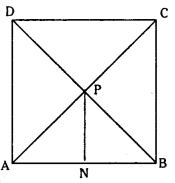
Since a diagonal is parallel to y = x its sides are parallel to the coordinate axes AB = BC = CD = DA = 4 Centre of the square P = (3, 7) and one diagonal is parallel to y = x ⇒ x – y = 0 ……. (1)
⇒ AB, CD lines are parallel to X-axis and remaining two sides BC, AD are parallel to Y-axis. Vertices of the square ABCD are
A = (x1, y1), B = (x1 + 4, y1) ;
C = (x1 + 4, y1 + 4), D = (x1, y1 + 4)
Centre of ABCD is (3, 7) and point of intersection of diagonals is (3, 7)
∴ \(\left(\frac{x_1+x_1+4}{2}, \frac{y_1+y_1+4}{2}\right)\) = (3, 7)
⇒ \(\left(\frac{2 \mathrm{x}_1+4}{2}, \frac{2 \mathrm{y}_1+4}{2}\right)\) = (3, 7)
⇒ x1 + 2 = 3, y1 + 2 = 7
⇒ x1 = 1 and y1 = 5
∴ Coordinates of vertices are
A = (1, 5), B = (1 + 4, 5) = (5, 5)
C = (1 + 4, 5 + 4) = (5, 9)
and D = (1, 5 + 4) = (1, 9)
Question 7.
If ab > 0, find the area of the rhombus enclosed by the four straight lines
ax ± by ± c = 0 (S.A.Q)
Answer:
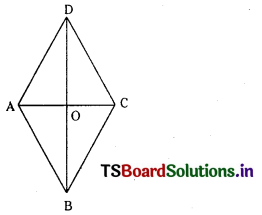
Equation of AB is ax + by + c = 0 …………………. (1)
Equation of CD is ax + by – c = 0 …………………. (2)
Equation of BC is ax – by + c = 0 ……………………. (3)
Equation of AD is ax – by – c = 0 ………………………. (4)
Solving (1) and (3) Coordinates of B are \(\left(\frac{-c}{a}, 0\right)\)
Solving (1) and (4) Coordinates of A are \(\left(0, \frac{-c}{b}\right)\)
Solving (2) and (3) Coordinates of C are \(\left(0, \frac{\mathrm{c}}{\mathrm{b}}\right)\)
Solving (2) and (4) Coordinates of D are \(\left(\frac{\mathrm{c}}{\mathrm{a}}, 0\right)\)
Area of Rhombus
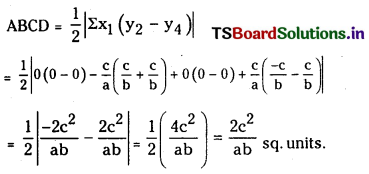
![]()
Question 8.
Find the area of the parallelogram whose sides are 3x + 4y + 5 = 0, 3x + 4y – 2 = 0, 2x + 3y + 1 = 0 and 2x + 3y – 7 = 0. (S.A.Q.)
Answer:
Given sides are
3x + 4y + 5 = 0 …………….. (1)
3x + 4y – 2 = 0 ……………… (2)
2x + 3y + 1 = 0 …………….. (3)
2x + 3y – 7 = 0 ……………. (4)
Area of parallelogram formed by (1), (2), (3). (4)
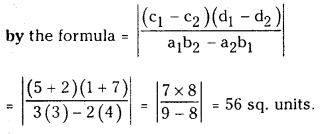
Question 9.
A person standing at the junction (crossing) of two straight paths represented by the equations 2x – 3y + 4= 0 and 3x + 4y – 5 = 0 wants to reach the path Whose equation is 6x – 7y + 8 = 0 in the least lime. Find the equation of the path that he should follow. (S.A.Q)
Answer:
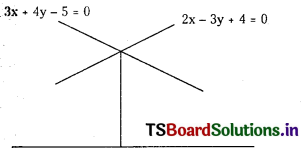
By Solving 2x – 3y + 4 = 0 and
3x + 4y – 5 = 0 we get
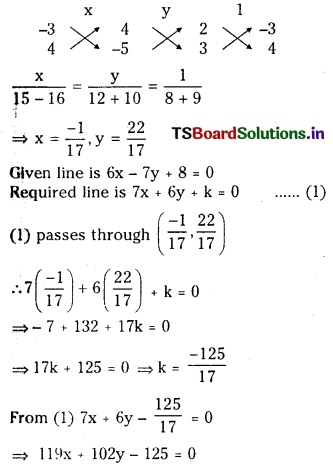
![]()
Question 10.
A ray of light passing through the point (1, 2) reflects on the X – axis at a point A and the reflected ray passes through the point (5, 3). Find the coordinates of A. (S.A.Q.)
Answer:
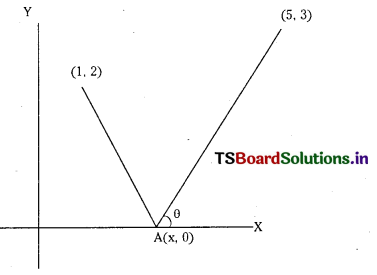
Let m be the slope then the equation of the line passing through (1, 2) is y – 2 = m (x – 1)
⇒ m = \(\frac{y-2}{x-1}\)
Let – m be the slope of the reflected ray then the equation of the line passing through (5, 3) is y – 3 = – m (x – 5)
⇒ m = \(\frac{y-3}{5-x}\)
∴ \(\frac{y-2}{x-1}=\frac{y-3}{5-x}\) ∴ Since A lies on X-axis
then y = 0 ∴ \(\frac{-2}{x-1}=\frac{-3}{5-x}\)
⇒ 2(5 – x) = 3(x – 1)
⇒ 5x = 13 ⇒ x = \(\frac{13}{5}\)
∴ A = (\(\frac{13}{5}\), 0)